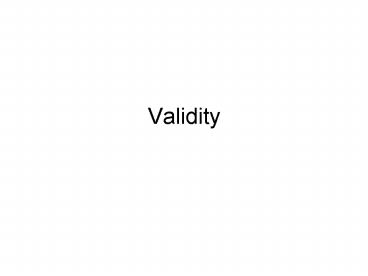Validity - PowerPoint PPT Presentation
1 / 20
Title:
Validity
Description:
It should be unrelated to unlike, dissimilar behaviors or tests (discriminant) ... Example: Love (think evidence) Convergent. Positive relationship to in ... – PowerPoint PPT presentation
Number of Views:88
Avg rating:3.0/5.0
Title: Validity
1
Validity
2
Definitions
- Extent to which a test measures what it purports
to measure - Extent to which a test is used in an impartial,
just, and equitable way - Validity is what the test measures and how well
it does so (Anastasi, 1954) - A test is valid to the degree that we know what
it measures or predicts (Cronbach, 1954) - Validity trustworthiness
3
Validity Process
- Validity is determined through an ongoing process
not a single score or decision - through theory and hypotheses
- through correlations, regressions, and factor
analysis - through an examination of the consequences
- Validity is a characteristic of test scores and
their use, not of the test itself
4
3 Traditional Methods
Logical
- Content validity
- Construct validity
- Criterion-related validity
- predictive concurrent
Empirical
5
What is Content Validity?
- Are the behaviors sampled by the test
representative of the attribute being assessed? - Am I fully measuring what I think I am measuring?
- Steps
- Describe the content domain
- Identify domains measured by the test
- Compare the structure of the test with the
content domain to analyze representativeness
6
Determining Content Validity
- Primary outcome is a judgment about how well the
test samples the content domains of the attribute - No statistical tests to determine
- Easier to assess for concrete domains
- Facts vs. abstract/complex concepts
7
Content Validity Strategies
- What can you do to ensure a high degree of
content validity? - Align content to standards carefully
- Engage multiple stakeholders in the development
and auditing process - Seek domain specific expert opinion
8
What is Construct Validity?
- What are Constructs?
- names associated with hypothetical abstract
concepts, but still connected with observable
entities - Why are they important?
- constructs are the central means we have for
connecting operations in research to language
communities - they often carry social and political
implications - the naming of things is a key problem for all
sciences
9
Construct Validity
- Does a test provide a good measure of the
construct of interest? - Usually an ongoing process that involves
continual development and change and refinement - Takes the form of an argument, presenting
evidence for and against
10
Construct Validity
- Construct explication
- identify behaviors related to construct
(convergent validity) - identify other constructs and decide if they are
related or not (discriminant validity) - Establish nomological networks
- identify behaviors related to each additional
construct and assess relationships - interrelated laws supporting a construct
11
Types of Construct Validity
- Convergent validity
- the correlation between like behaviors/measures/
constructs (e.g., similar or the same constructs) - Discriminant validity
- the correlation between unlike or dissimilar
measures
12
Calculating Construct Validity
- Correlate scores on test with other measures or
tests - It should have significant correlations with
similar behaviors or tests (convergent) - It should be unrelated to unlike, dissimilar
behaviors or tests (discriminant) - Factor analysis (unidimensionality)
13
Example Construct of Love
- Define love
- Grounded in existing theoretical and popular
conceptions of love - Measure it
- highly inter-correlated items (r .85)
- factor analysis
- assess its relationship to similar and dissimilar
variables, i.e., hate, like, (discriminant)
14
Example Love (think evidence)
- Convergent
- Positive relationship to in loveness scale
- Positive relationship to probability of marrying
coefficient - Positive relationship to never felt this before
coefficient - Positive relationship with gazing adoringly
- Discriminant
- Positive but different relationship to self
reported friendness coefficient (i.e. like, not
love) - Negative relationship to hate coefficient
- Negative relationship to social desirability
scale - Positive relationship to glancing
Herman (2004)
15
Convergence Correlation Matrix
Herman (2004)
16
Discriminant Correlation Matrix
Keith Herman (2004)
17
What is Criterion Validity?
- Judgment regarding how well a test can be used to
infer an individuals standing on a measure of
interest (the criterion). - Criterion should be reliable, relevant, and
valid. - The primary concern is prediction how well the
test predicts the criterion of interest.
18
Types of Criterion Validity
- Predictive (over time)
- follow subjects over time
- limited by time and feasibility
- Concurrent (at the same time)
- single point in time and pre-selected subjects
- limitations restricted range
19
The Language of Validity
Validity of Inferences
inside the test
relationship to other tests
internal
external (generalizeability)
construct
content
criterion
tradition
convergent
discriminant
reliability
concurrent
predictive
inter-rater
parallel forms
internal
test retest
when we talk about validity we are addressing
reasons why we might not trust inferences
20
Wrap-up
- Validity is a complex, evolving judgment about
the quality inferences made from test scores - Recent attention has focused not only on the
psychometric properties of a test (i.e.,
reliability and conventional validity) but also
on the social consequences related to test use - Awareness of social consequences of assessment is
critical for both researchers and educators alike































